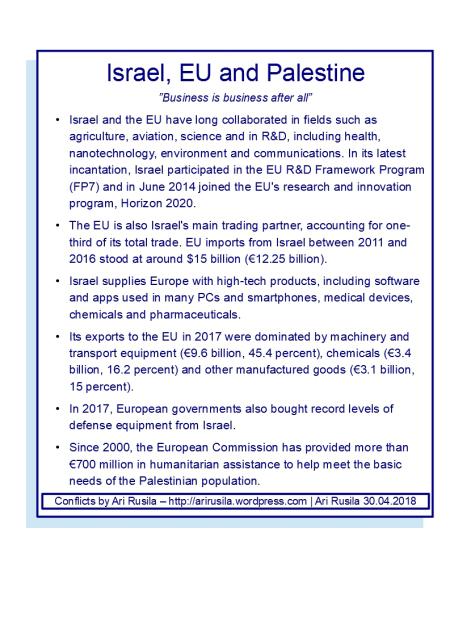“When we are brave, we are getting closer toward martyrdom, martyrdom, martyrdom…we say to Nikki Haley, to Netanyahu, to the criminal Lieberman we are afraid neither of death nor of martyrdom.” (Senior Hamas leader Ismail Radwan on 27th Apr. 2018)
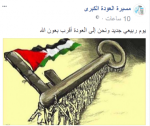 “The Great Return March” Campaign has now been implemented a month and probably it will will climax on May 15 (Nakba Day) 2018 with aim of a massive procession of 100,000 Gazans storming the Israel security fence around Gaza. The main goal of this action is not immediately to kill Israelis but to get attention by getting Gazans killed themselves as when Israel must use lethal force to protect Israelis and Israeli border this will bring the Palestinian case back to the agenda and the media headlines will come back.
“The Great Return March” Campaign has now been implemented a month and probably it will will climax on May 15 (Nakba Day) 2018 with aim of a massive procession of 100,000 Gazans storming the Israel security fence around Gaza. The main goal of this action is not immediately to kill Israelis but to get attention by getting Gazans killed themselves as when Israel must use lethal force to protect Israelis and Israeli border this will bring the Palestinian case back to the agenda and the media headlines will come back.
Behind the hypcrate statements from international organizations and behind the body count of main stream media I would like to highlight some other aspects of this ongoing play.
Same place, same time. Same sad abuse by terrorist #Hamas of the weakest parts in Gazan society for its hostile charade.
Don’t be part of the show and don’t be fooled. This is terror, just masked.
The IDF will continue to defend our people and border. pic.twitter.com/iQU0nF2hJf— Jonathan Conricus (@LTCJonathan) April 27, 2018
The Great Return March campaign exhausted?
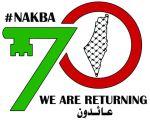 It is no secret that the campaign of protests at the border has been a disappointment for Hamas, as it failed to meet the group’s initial expectations. The number of participants (average Gazans, no-Hams members) has diminished from week to week, and Yahya Sinwar, the head of Hamas in the Gaza Strip and his associates, including many high-ranking officials in the group’s military wing, feel that the campaign has exhausted itself. They say that if Hamas continues to conduct the campaign as it is currently being handled, it will erase any achievement it has managed to reach.
It is no secret that the campaign of protests at the border has been a disappointment for Hamas, as it failed to meet the group’s initial expectations. The number of participants (average Gazans, no-Hams members) has diminished from week to week, and Yahya Sinwar, the head of Hamas in the Gaza Strip and his associates, including many high-ranking officials in the group’s military wing, feel that the campaign has exhausted itself. They say that if Hamas continues to conduct the campaign as it is currently being handled, it will erase any achievement it has managed to reach.
The popular turnout is diminishing week by week. Some 3,000 protesters turned out on 20th April, significantly smaller than the 10,000-15,000 at previous Friday’s demonstration. In the three weeks before, there were an estimated 20,000 and 30,000 protesters, respectively.
However some 10,000-14,000 Palestinians participated March on Border for fifth week [27.-28.4.2018] but only four (3 on Friday and 1 wounded died on Saturday) was killed and over 600 injured (174 wounded due use of live ammunition) – lower figures anyway than during first week.
According Hamas the weekly Gaza border riots will not end on May 15th, the day the Arabs mark as ‘Nakba’ or “Catastrophe” in Arabic (Israel’s rebirth as a state), but will continue through Ramadan, Hamas political bureau chief Ismail Haniyeh said on 26th Apr 2018 according JewishPress. The events at the Gaza border “brought the Palestinian issue back to center stage, and revived the memory of the right of return,” Haniyeh said. He claimed the demonstrations would also have the effect of spoiling the Israeli celebrations marking the move of the U.S. Embassy to Jerusalem on May 14, as well as the Jerusalem Day celebrations on the day prior (May 13), marking Israel’s victory in the 1967 Six Day War. Haniyeh added that the demonstrations would no longer be limited to the Gaza border, but are to be expanded and spread throughout Judea and Samaria. At a press conference held by the “supreme national authority of the great return march,” it was stated that on May 15, 2018, all the demonstrators would move towards the security fence to cut through the barbed wire, calling on the international community to protect them (al-Aqsa, April 17, 2018).
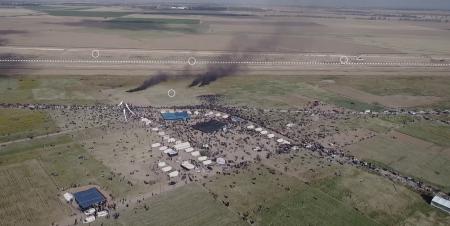
A protest in Khan Younis on March 30. The photographer, Yasser Murtaja, was killed in a protest in the same location the following week. Aerial image by Yasser Murtaja, Ain Media
Behind body count
According The Meir Amit Intelligence and Terrorism Information Center the Hamas-controlled ministry of health in the Gaza Strip reported that 40 [now 44] Palestinians have been killed during the “great return march” events since March 30, 2018, when the rioting began along the Gaza Strip-Israel border (updated to April 25, 2018); 32 of the 40 Palestinians killed (80%) were terrorist operatives.
One significant aspect with ongoing fence-storming campaign is that not a single rocket has been fired into Israel from Gaza in over two months, yet since March 30 during fence-storming more Palestinians in Gaza have been killed than it did in the previous 16 months, during which time militants launched over 60 rockets and mortars. Another aspect more: Compared the death ratio of civilians vs militants, it is now 1:5 as during previous Gaza conflicts/wars it was about 2:1 so this ”peaceful” demonstration seems to be much better for civilian population as terrorists can not use them so much as human shields than during previous conflicts.
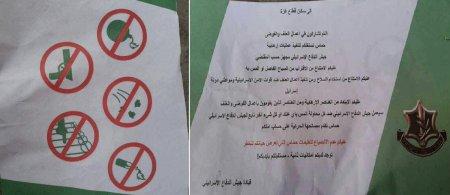
Israeli army leaflets dropped over Gaza to warn Palestinian demonstrators not to approach the border fence
All violent deaths are not made by IDF. Arab media outlets reported that the explosion occurred in the town of Beit Lahiya killing 55-year-old Mohammed Nimr Maqadmah – a member of the Hamas terror group’s military wing, it is unclear if Maqadmah was killed in a targeted killing, or in an accidental explosion while building a bomb. Local media outlets initially claimed the explosion was the result of an Israeli drone attack, but subsequent reports by Arab news sources suggested the explosion may have been an accident. Three other people were injured in the explosion, one of which is reportedly Maqadmah’s son. On Sunday night, a Hamas terrorist from the Al-Qassam Brigades was killed during a tunnel collapse in the central Gaza Strip. The terrorist was identified as 33-year-old Tha’er Nayef az-Zare’ey. Source: Arutz Sheva , more in report by The Meir Amit Intelligence and Terrorism Information Center
In addition there was a funeral of Fadi al-Batsh in the Jabalya refugee camp in the central Gaza Strip on 27th April where thousands attended. Al-Batsh, a Palestinian engineer working for Hamas on weapons projects was killed in Malaysia and whose death was attributed by foreign media outlets to the Mossad.
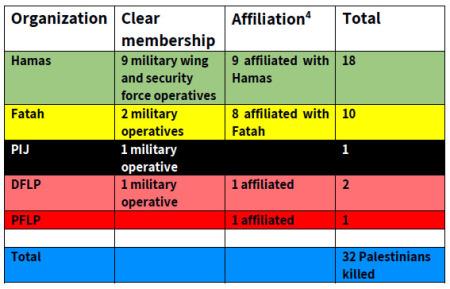
Identities of Palestinians killed during the “great return march” who were terrorist operatives or affiliated with terrorist organizations
A quarrel inside Hamas
Sources in Egypt and within Hamas confirm that a quarrel over an Egyptian initiative to end Gaza border marches has split Hamas into two opposing camps, Israel Hayom recently learned from senior Hamas sources. Tensions within Hamas’ leadership have caused a rift between the two strongest and influential people in the movement today – Ismail Haniyeh, the political bureau chief, and Yahya Sinwar, the head of Hamas in the Gaza Strip. Sinwar is displeased with the fact that Haniyeh has chosen to remain in Gaza. This decision breaks with years of tradition, as his predecessor, former political bureau chief Khaled Mashaal, managed the movement’s affairs from Syria before moving operations to Qatar. Sinwar has complained to his associates that Haniyeh was intervening in internal affairs.
The rift exacerbated an already strained relationship between the two “exploded” after Haniyeh snubbed Egyptian efforts to discuss a possible prisoner swap deal with Israel and an easing of the blockade on Gaza in exchange for a cessation of the border demonstrations. A delegation of Egyptian intelligence and security officials visiting Gaza submitted a proposal to Haniyeh. According to a senior Hamas official, Hamas then received an ostensibly improved offer from Egypt to halt the campaign of border demonstrations in exchange for the possibility of significantly advancing a potential prisoner exchange deal with Israel, in addition to its offer of opening the Rafah terminal and easing the blockade on Gaza.
Haniyeh reportedly rejected the Egyptian proposal without consulting the heads of the movement or even divulging its details to the organization’s leadership. “Not only did Haniyeh reject the improved proposal,” a senior Egyptian intelligence official told Israel Hayom, “he even rejected the invitation we gave him to come to Cairo with a delegation of Hamas officials to discuss details of the deal to stop the marches on the border and the possibility of a prisoner exchange.”
Meet the real Hamas, the terrorist organization that runs the Gaza
Strip pic.twitter.com/3UZjwC5QkE— IDF (@IDFSpokesperson) April 20, 2018
High-ranking Hamas officials, including Sinwar, were furious with Haniyeh and had accused him of coordinating Hamas policy with Tehran rather than the group’s own leadership. According the Egyptian official “Sinwar exploded with rage and screamed at Haniyeh,” the official said “when he learned that [Haniyeh] wasn’t planning to accept the Egyptian delegation’s proposal.”
Meanwhile, a senior Hamas official in Gaza told Israel Hayom there are voices in Hamas that argue that the border marches have run their course in their current format and that the diminishing number of demonstrators from week to week is actually undermining the potential for the grand finale demonstration. The official said that Sinwar and other high-ranking Hamas figures share this view. Furthermore, an associate close to Sinwar told Israel Hayom that the Sinwar camp believes that if the border marches continue in their current format it could undo any progress that has been made thus far and that it could undermine the general Palestinian interests as well. According to Sinwar, Haniyeh made a terrible mistake by rejecting the first Egyptian proposal and an even bigger mistake in rejecting the revised proposals.
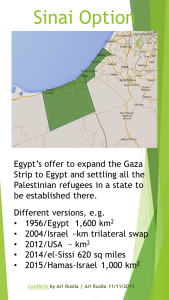 Sinwar’s associates say that while he has worked tirelessly, in conjunction with other Hamas figures, to rehabilitate the group’s relations with Egypt, Haniyeh undermined Sinwar’s efforts by offending the Egyptians’ honor when he refused an invitation to come to Cairo to discuss an Egyptian proposal for Hamas.
Sinwar’s associates say that while he has worked tirelessly, in conjunction with other Hamas figures, to rehabilitate the group’s relations with Egypt, Haniyeh undermined Sinwar’s efforts by offending the Egyptians’ honor when he refused an invitation to come to Cairo to discuss an Egyptian proposal for Hamas.
The relations between Egypt and Hamas have been one core question in (partial) Israeli-Palestinian peace process. Besides planned Hamas-Israel ceasefire deal Egypt has a decisive role if sc ‘Sinai option’ (more in Sinai Option again) will go further as partial solution to conflict. Also even without these kind progress Egypt’s actions with Rafah crossing have great importance for welfare of Gaza population.
Long truce?
Jerusalem Post reports that European groups recently passed on to Hamas a wide-reaching proposition to solve the humanitarian crises in Gaza. The proposed deal is that Hamas would relinquish armed struggle against Israel for at least five years and in exchange, an EU-created institution would pay the salaries of the Gaza strip civic administration and run all humanitarian affairs there.
This offer is unique in including an assumption of comprehensive authorities by a European body that would operate in the Gaza strip. For Hamas, it may be tempting that the financial aid for health, education and developing public administration would come directly from a European body and not via the Palestinian Authority in the West Bank, currently controlled by Mahmoud Abbas, as is currently the practice. Hamas refused the demands made by Abbas that the security, legal and tax collecting powers in the Gaza strip be handed over to the PA as a condition for national reconciliation.
The Hamas negotiation team is reportedly still studying the European offer before responding to it. Officially Hamas denies any offer from EU and there is no confirmation about neither from EU.
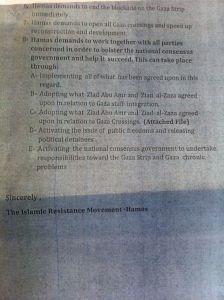
2015 “no-paper”
The concept of connecting wide-scale humanitarian and financial aid to Gaza with Hamas rejecting terrorism and violence is not new and it might be possible that also this time the question is about unofficial talks with or without ”white papers”. For example few years ago according Israel Hayom [18th Aug. 2015] as well the Times of Israel reported that Hamas and Israel essentially agreed on a long-term cease-fire. A “comprehensive” agreement between Hamas and Israel included e.g. lifting of an blockade placed on the Gaza Strip in return for a long-term ceasefire. The gist of the deal is that Israel will end the blockade and allow thousands of Palestinian day laborers to enter Israel. Gaza will import items through a Cyprus port overseen by NATO representatives (until a floating offshore port can be developed) and cease all rocket fire and tunneling for eight years. A prisoner swap may be in the works too. I predicted then that this kind of Hamas-Israel Deal could pave way for the ‘Cold Peace Solution’ and this new EU proposal could do the same job if true and agreed. [More in Hamas and Israel on Verge of the Deal and Gaza State Under Construction, West Bank Remains Bystander ]
PA
Palestinian Authority President Mahmoud Abbas does not have a mandate from his people to reach any agreement with Israel: his term in office expired in January 2009. For Abbas last Hamas-Fatah deal is a boost to his sagging popularity and same time a likely blow to any challenge from Mohammed Dahlan and other potential rivals if elections go ahead.
Earslier Saudi Arabia’s crown prince Mohammed bin Salman (MbS) reportedly told Palestinian President Mahmoud Abbas to accept the plan or resign. It is likely that MbS did this to hasten the sidelining of the Palestinian issue so that he could facilitate normalisation with Israel.
The Kingdom of Jordan began the process of revoking the Jordanian citizenship of about 30 Palestinian Authority and Fatah officials and their families, London-based Arabic language newspaper Raialyoum reported according Jpost and Alaraby The officials who are slated to lose their citizenship include Palestinian Authority President Mahmoud Abbas, Chief Palestinian negotiator Saeb Erekat and Palestinian Authority negotiator Ahmed Qurei (“Abu Ala”). They also stated that there would be major changes in the visa arrangements for entry into Jordan of the senior officials, granting them only temporary visitor’s rights. Jordan granted citizenship to Palestinians in the West Bank after extending sovereignty to the territory following its capture in the 1948 Arab-Israeli war. King Hussein officially severed Jordan’s legal and administrative ties to the West Bank in 1988, relinquishing claims to sovereignty and withdrawing Jordanian nationality from Palestinian residents.
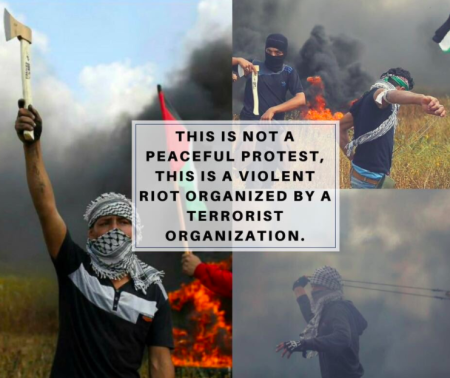
Epiloque
Today it seems clear that the Great Return March” is not a peaceful demonstration. Gazans are trying to infiltrate into Israel, damage its infrastructure and kill Israelis; it is a massive attempt by dozens of rioters to breach a border fence less than a kilometer from Israeli civilians.From my viewpoint the IDF operates to protect Israeli civilians and will not allow harm to be done to the security infrastructure that protects them. According IDF the snipers only fire under direct order from a battalion commander or officer of higher rank to neutralize situations in which the fence could be breached.What would be the alternative as a breach would require the IDF to open deadly fire at hundreds or thousands of Gazans trying to break into Israel.
Interesting detail with ongoing ”Return March” is that Hamas used that exact same tactic to breach the Egyptian border 10 years ago. On January 22, 2008, a group of unarmed Hamas demonstrators–mostly women–rushed the Rafah border crossing between Gaza and Egypt and managed to break through. That night, Hamas operatives planted explosives along the border wall in several places, creating huge gaps in it. The next day, anywhere from 200,000 to 750,000 Gazans (estimates vary) poured through those breaches into Egypt.
In 2005, the Palestinians of Gaza had a choice. They could have used their newly acquired freedom to build a strong economy in that coastal and fertile land, or they could have used that freedom to fight Israel. The fact that they chose the latter is not Israel’s responsibility, and it is not too late for Gaza’s Palestinians to choose a different path.
Israel could independently implement a ‘Cold Peace Solution’, a minimal level of peace relations, to ensure its character as a Jewish and democratic state, by fixing a border between Israel and a future Palestinian state in the West Bank unilaterally.
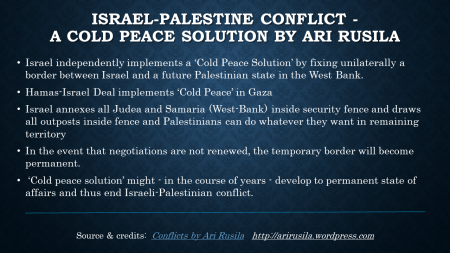
Some of my previous related articles:
Western Donors Still Funding Terrorists
Hamas and Israel on Verge of the Deal
Gaza State Under Construction, West Bank Remains Bystander
Gaza Update: Hamas Downfalling – IDF Prepared
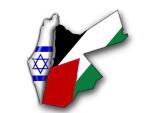
Appendix: Israel, EU and Palestine
